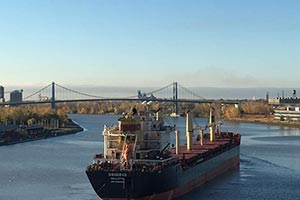Mild Winter Reduced Cargo at Port of Toledo

Toledo, Ohio-area drivers and most businesses may have welcomed a mild winter last year, but it bit into the amount of cargo moving through the city’s port.
The six-figure drop in the amount of rock salt delivered to Toledo docks wasn’t enough to keep the Port of Toledo from reporting an overall increase in cargo tonnage during 2016, however, thanks in large part to rebounding coal traffic and growth in metals and bulk liquids, a year-end report from the Toledo-Lucas County Port Authority shows.
The high-value general and miscellaneous cargo sector was buoyed by a record year for aluminum shipments, said Joe Cappel, the port authority’s vice president for business development.
And while the Toledo docks’ iron-ore traffic also declined sharply for a second straight year, it picked up late in the season after an Indiana smelter closed and could recover in 2017.
Overall, Cappel said, the local port trailed its 2015 numbers for most of 2016.
“The season finished so strong,” he said. “It kind of lagged behind 2015 for so long.”
Aluminum accounted for about 200,000 tons, or about five-sixths of the port’s general cargo traffic. Much of the rest was steel and other metals, but it also included bagged calcium and some heavy-machinery shipments for a new gas-burning power plant in Oregon.
While it’s the smallest cargo sector, general cargo is among the most beneficial to the port because its value and handling generates more jobs and revenue than do bulk materials whose handling is highly mechanized.
For the coming year, Cappel said, there have been inquiries about shipping wind-turbine components, refinery equipment and machinery through Toledo’s port.
Midwest Terminals of Toledo, which operates the port’s International Cargo Dock and the newer Ironville Dock, “has been really good about pursuing any opportunity that comes their way,” Cappel said.
Salt, handled in dry bulk, fell from 441,870 tons during 2015 to 169,635 tons last year, which is consistent with a sharp drop in the area’s salt use during the 2015-2016 winter after two years of above average snowfall.
But road construction, another bane for Toledo-area drivers, was busy in 2016, and Cappel said that resulted in a good year for the port’s cement terminals.
Cappel said a decline in limestone headed to the Toledo Edison Bay Shore power plant also cut into the dry-bulk category, while railroad ballast stone and petroleum coke remained strong.
Coal, which historically dominated Toledo port tonnage but has declined significantly in recent decades because of its declining use in electricity generation and shrinking North American production of new steel, increased by just over 50% in 2016.
“We had at least one new customer” and other coal consumers increased their demand, Cappel said.
For many years, iron ore across Toledo’s dock has gone to AK Steel mills in Middletown, Ohio, and Ashland, Kentucky.
During its two years of operation, the new Magnetation iron smelter in Reynolds, Indiana, had captured much of the Middletown business, but the smelter closed in early October. After that a steady flow of ore pellets resumed at the Toledo Ore Railroad Co. dock in Oregon.
Toledo’s iron-ore traffic is unlikely to approach its 2014 recent peak of more than 4.1 million tons because the Ashland mill closed in late 2015 and has an uncertain future.
Hot steel slabs Ashland formerly sent to the Middletown works for rolling into sheets now are produced at the former Rouge Steel in Dearborn, Michigan, which AK acquired in 2014. AK blamed Ashland’s closing on unfair pricing by Chinese steel producers that resulted in United States tariffs this year.
Grain through Toledo’s port, which historically rose and fell with the quality of local harvests, has been relatively stable in recent years. Cappel said that stability arrived after what is now the Mondelez flour mill on Front Street began receiving wheat by ship — grain that counts equally in the port’s report with outbound shipments from Maumee River elevators.
The port currently is receiving natural-gas pipeline for the controversial NEXUS project by rail, but only shipments that enter or leave the port on ships are counted in the seaport statistics. That also excludes oil arriving by train at Ironville Dock that then is trucked to local refineries.
The Lake Carriers’ Association, which represents U.S.-flagship owners on the Great Lakes, reported its cargo total for 2016 was down 4.5% for the year, to 83 million tons, with iron ore up but other principal commodities — including coal, limestone, cement, salt, sand and grain — declining.
By law, foreign ships are forbidden to haul cargo shipped from one U.S. port to another. Canadian vessels dominate lakes trade between Canada and Toledo, while foreign-flag ships command overseas shipments.

